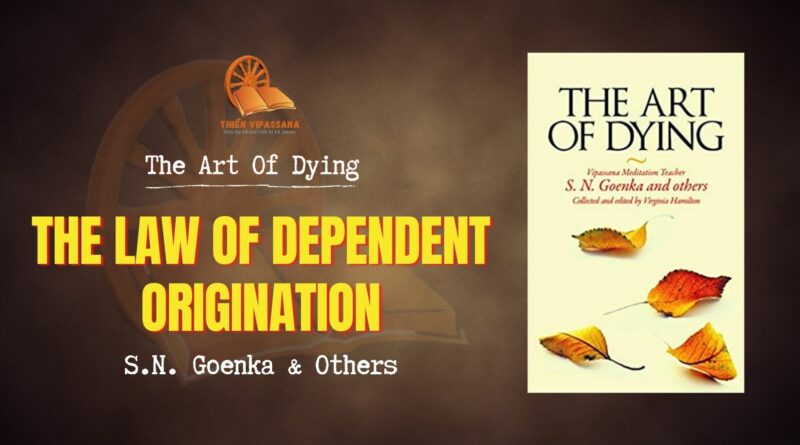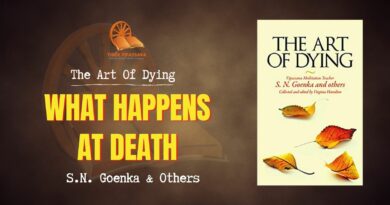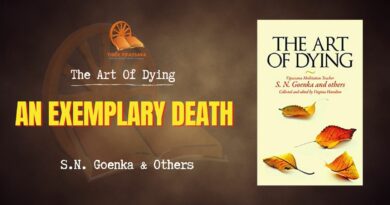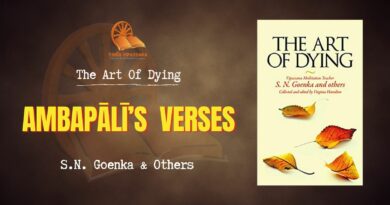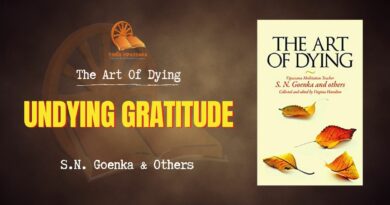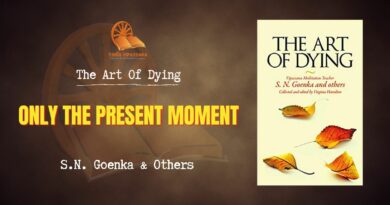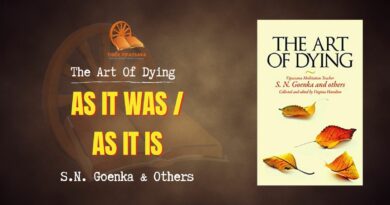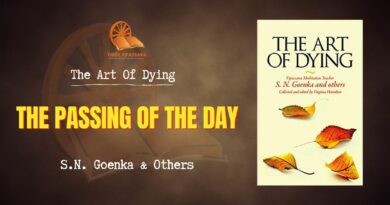Paṭicca Samuppāda
The Law of Dependent Origination
According to the Buddha, our present is the fruit of our past thoughts, words and deeds. Thus, moment by moment our future is shaped by the things we think, say and do in the present. The Buddha’s message is profound. Practicing seriously, we realize its unavoidable truth, facing it head-on in our meditations and as we carry out our daily lives. The fact that we are responsible for our future, and that by mastering our minds we can shape it, becomes very clear. Our understanding and acceptance of this law—the law of dependent origination, paṭicca samuppāda—is what brings us peace of mind and opens the door to our liberation.
The Buddha spent eons developing the qualities necessary to become fully enlightened—to learn the way out of suffering. Out of deep compassion he offered his discovery to all beings— fearful, angry, greedy, helpless, discouraged, ill, old and dying— so that they too could free themselves from their suffering.
It is a long and difficult path. It can seem so much easier to stick to our old familiar habits of mind, to prefer the pain and suffering of patterns we already know, than to face the discomforts of change that come with training the mind.
Our lives are difficult. There are many days when we feel exhausted and stressed. Rather than face the internal source of our misery, we crave distraction and pleasantness; and so we allow meditation to slip to the bottom of our priority list. Breaking the powerful old habit of craving the pleasant to avoid the unpleasant can seem impossible. But when we are ready to make the effort, the Buddha has provided the perfect tool to make fundamental change.
Following is Goenkaji’s explanation of paṭicca samuppāda, from Day 5 of The Discourse Summaries.
Obviously the sufferings of life—disease, old age, death, physical and mental pain—are inevitable consequences of being born. But what is the reason for birth? Of course the immediate cause is the physical union of parents, but in a broader perspective birth occurs because of the endless process of becoming in which the entire universe is involved. Even at the time of death the process does not stop: the body continues decaying, disintegrating, while the consciousness becomes connected with another material structure and continues flowing—becoming.
And why this process of becoming? It was clear to the Buddha that the cause is the attachment one develops. Because of attachment one generates strong reactions, saṅkhāras, that make a deep impression on the mind. At the end of life, one of these saṅkhāras will arise in the mind and give a push so that the flow of consciousness continues.
Now what is the cause of this attachment? The Buddha found that it arises because of the momentary reactions of liking and disliking. Liking develops into great craving; disliking into great aversion, the mirror image of craving; and both turn into attachment.
Why do these momentary reactions of liking and disliking arise? Anyone who observes himself will find that they occur because of bodily sensations. Whenever a pleasant sensation arises, one likes it and wants to retain and multiply it. Whenever an unpleasant sensation arises, one dislikes it and wants to be rid of it.
What causes these sensations? Clearly they occur because of contact between any of the senses and an object of that particular sense: contact of the eye with a vision, of the ear with a sound, of the nose with an odor, of the tongue with a taste, of the body with something tangible, of the mind with a thought. As soon as there is contact, a sensation is bound to arise—pleasant, unpleasant, or neutral.
What is the reason for contact? Obviously, the entire universe is full of sense objects. So long as the six senses—the five physical ones, together with the mind—are functioning, they are bound to encounter their respective objects.
And why do these sense organs exist? It is clear that they are inseparable parts of the flow of mind and matter; they arise as soon as life begins.
Then why does the life-flow, the flow of mind and matter, occur? It is because of the flow of consciousness from moment to moment, from one life to the next.
So why do we have this flow of consciousness? The Buddha found that it arises because of saṅkhāras, the mental reactions. Every reaction gives a push to the flow of consciousness; the flow continues because of the impetus given to it by reactions.
And why do reactions occur? He saw that they arise because of ignorance. One does not know what one is doing, does not know how one is reacting, and therefore one keeps generating saṅkhāras. As long as there is ignorance, suffering will remain.
The source of the process of suffering, the deepest cause, is ignorance. The chain of events by which one generates mountains of misery for oneself starts from ignorance. If ignorance can be eradicated, suffering will be eradicated.
How can one accomplish this? How can one break the chain? The flow of life, of mind and matter, has already begun. Committing suicide will not solve the problem; it will only create fresh misery. Nor can one destroy the senses without destroying oneself. So long as the senses exist, contact between them and their respective objects is bound to occur, and whenever there is contact a sensation is bound to arise within the body.
And it is here, at the link of sensation, that one can break the chain. Previously, every sensation gave rise to a reaction of liking or disliking that developed into great craving or aversion—great misery. But now, instead of reacting to sensation, you are learning just to observe with equanimity, understanding: “This will also change.” In this way sensation gives rise only to wisdom, to the understanding of anicca. One stops the turning of the wheel of suffering and starts rotating it in the opposite direction, towards liberation.
Any moment in which one does not generate a new saṅkhāra, one of the old ones will rise to the surface of the mind and, along with it, a sensation will start within the body. If one remains equanimous, it passes away and another old reaction arises in its place. One continues to remain equanimous toward the physical sensations and the old saṅkhāras continue to arise and pass away, one after another. If, out of ignorance, one reacts to sensations, then one multiplies the saṅkhāras, multiplies one’s misery. But, if one develops wisdom and does not react to sensations, then one after another, the saṅkhāras are eradicated, and misery is eradicated.
The entire path is a way to eradicate misery. By practicing, you will find that you stop tying new knots, and that the old ones are automatically untied. Gradually you will progress toward a stage in which all saṅkhāras leading to new birth, and therefore to new suffering, have been eradicated: the stage of total liberation, full enlightenment.
To start the work, it is not necessary that one should first believe in past lives and future lives. In practicing Vipassana the present is most important. Here in the present life, we keep generating saṅkhāras and continue to make ourselves miserable. Here and now one must break this habit and start coming out of misery. If you practice, certainly a day will come when you will be able to say that you have eradicated all the old saṅkhāras, have stopped generating any new ones, and so have freed yourself from all suffering.
—S.N. Goenka
There is no cause without an effect and there is no effect without a cause. The law of kamma is supreme and inevitable. What you have now is the result of what you have done in the past. Until we get rid of the forces of kamma which belong to us, once and for all, and enter the supreme nibbāna, there is bound to be some trouble or other, here and there, during the remainder of our existence, that we must put up with, using the strength of anicca. Anicca will surely prevail upon them and you will keep yourself in good stead in spite of all these difficulties. Anicca is power. Thorns in the way are inevitable. Make use of the power of anicca with diligence and peace will be with you.
—Sayagyi U Ba Khin
Every life is a preparation for the next death. If one is wise, one will use this life to the best advantage and prepare for a good death.
—S.N. Goenka
Bài viết này được trích từ cuốn sách The Art of Dying – Thiền Sư S.N.Goenka và nhiều tác giả khác.

